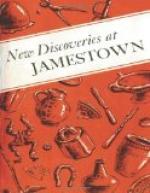The foregoing has been a summary of the physical aspect of the Jamestown settlement from the standpoint of archeology. An account of the arts and crafts revealed by the artifacts found in these explorations follows. The whole story relating the settlers themselves to evidence they left in the soil of Jamestown remains to be told.
PART TWO
Daily Life at Jamestown 300 Years Ago As Revealed by Recovered Objects
By J. Paul Hudson
Museum Curator, Colonial National Historical Park
“Hitherto they [historians] have depended too much upon manuscript evidences... Perhaps the day is not distant when the social historian, whether he is writing about the New England Puritans, or the Pennsylvania Germans, or the rice planters of Southern Carolina, will look underground, as well as in the archives, for his evidence.”—Dr. T.J. WERTENBAKER
Archeological explorations at Jamestown, Va.—site of the first successful English colony in the New World—have brought to light thousands of colonial period artifacts which were used by the Virginia settlers from 1607 until 1699.
A study of these ancient objects, which were buried under the soil at Jamestown for many decades, reveal in many ways how the English colonists lived on a small wilderness island over 300 years ago. Artifacts unearthed include pottery and glassware, clay pipes, building materials and handwrought hardware, tools and farm implements, weapons, kitchen utensils and fireplace accessories, furniture hardware, lighting devices, eating and drinking vessels, tableware, costume accessories and footwear, medical equipment, horse gear, coins and weights, and many items relating to household and town industries, transportation, trade, and fishing.
These artifacts provide invaluable information concerning the everyday life and manners of the first Virginia settlers. A brief description of many of them is given on the following pages.
Excavated artifacts reveal that the Jamestown colonists built their houses in the same style as those they knew in England, insofar as local materials permitted. There were differences, however, for they were in a land replete with vast forests and untapped natural resources close at hand which they used to advantage. The Virginia known to the first settlers was a carpenter’s paradise, and consequently the early buildings were the work of artisans in wood. The first rude shelters, the split-wood fencing, the clapboard roof, puncheon floors, cupboards, benches, stools, and wood plows are all examples of skilled working with wood.




